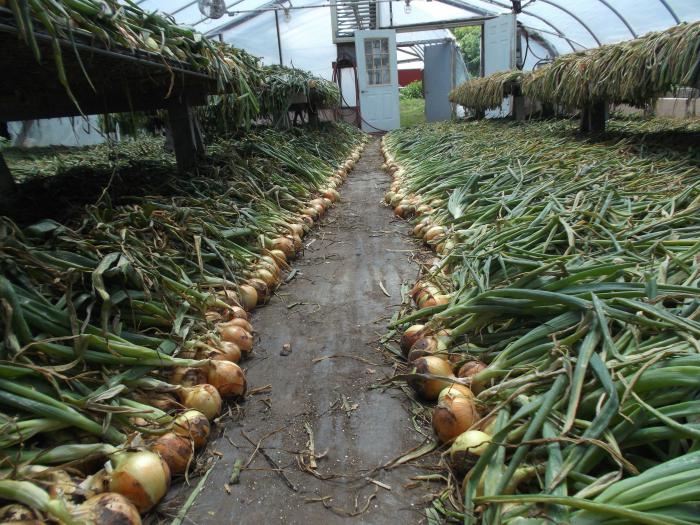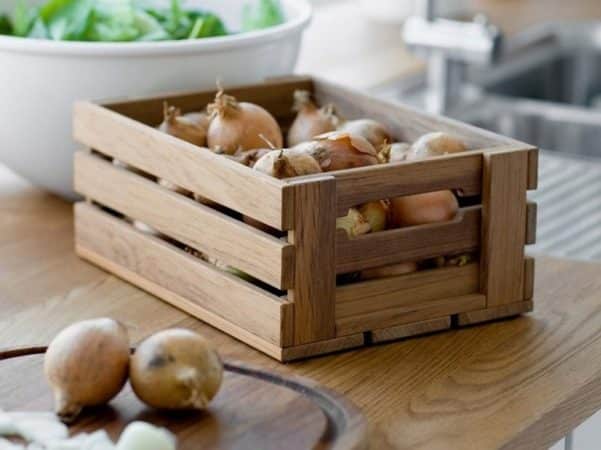When to remove heirloom onions from the storage bed
In order for family onions to be stored well, it is important to remove them from the beds promptly and correctly. In this case, it is necessary to take into account the planting region, varietal characteristics of the crop, and weather conditions. We will tell you in the article when and how to remove family onions from the garden.
Optimal timing for harvesting heirloom onions
Calendar dates for harvesting crops vary significantly depending on the zone growing, weather conditions, varietal characteristics and planting dates. Let's figure out when to harvest the onion family depending on these factors.

Depending on the region
To determine the optimal timing for harvesting heirloom onions, the climatic features of the growing area are taken into account: temperature and humidity.
In the middle lane
The temperate climate of the region is favorable for growing any type of onion, including family onions. If the summer was warm, with enough rain, they begin to remove turnips from the beds in the first ten days of July.
In outskirts of Moscow
Gardeners in the region plant onions in April. If the weather is favorable, the heads ripen by mid-July. If it was cold during the active formation of bulbs in June, harvesting is postponed to the end of July or beginning of August.
In the Urals
Climatic conditions Ural characterized by short summers. It becomes warm only in June, and in August it already gets cold and rains. In the Urals, varieties resistant to fungal diseases are grown. Therefore, the most favorable period for harvesting family onions is the first ten days of August.
In Siberia
Late spring frosts, sudden temperature changes, alternating rains and heat characterize Siberia as one of the most difficult regions for growing garden crops, including onions. Only spicy varieties can ripen here. They try to pick onions from the garden at the end of July or beginning of August.
On South
In the southern regions, early spring and long warm summers create the most favorable growing conditions for onions. With optimal watering and loosening, family onions for turnips ripen at the end of June.
Depending on the variety
The ripening time of shallots also depends on the length of the growing season of a particular variety. To determine when it is time to harvest, they focus on the time of planting the crop in the current year.
Harvesting time for early varieties
For early ripening varieties, the time from germination to harvesting onions for green feathers is about 20 days, and until leaves lodging takes from 40 to 65 days, depending on weather conditions.
Mid-early
Growing season mid-season family onion lasts from 50 to 80 days. Harvesting is carried out 2.5-3 months after planting the variety.
Late ripening
Head ripening time in such varieties the longest. Feather lodging occurs after 70-96 days. Signs of maturity appear 96-120 days after planting. Late-ripening varieties can ripen only in the southern regions.
Harvesting dates for varieties planted before winter
During winter planting onions send out roots already in the fall, and their spring awakening occurs immediately after the ground thaws. At the same time, the growing season and harvest are significantly reduced. Already 2 months after the emergence of seedlings, the harvest is obtained. In the middle zone - in June.
Depending on the weather
To determine the harvesting time, the weather conditions of the current summer are also taken into account. During hot weather, onions ripen a week faster. Cold summer lengthens the period of turnip formation by 1-2 weeks.
According to the lunar calendar
The family onions are harvested for storage during the waning moon. The most favorable period is when the celestial body is in Sagittarius, Capricorn or Aquarius. The Moon in Cancer leads to wateriness and rotting of the head.
In July, it is recommended to harvest onions on the 17th-19th, 22nd, 23rd, 27-29th; in August - from 1 to 7, 10, 26, from 29 to 31.
Signs that the crop is ready for harvest
10 days before the expected harvest date, you should carefully examine the feathers in the beds and the bulbs themselves.

The following signs will indicate the readiness of the crop for harvesting and storage:
- the onion greens have dried out and partially turned yellow;
- the feathers in the garden bed died by more than 50%;
- the neck became thin and soft;
- the upper scales on the turnip have dried out and acquired a color characteristic of the variety.
When fully ripe, the bulb is easily separated from the nest and pulled out of the ground.
Attention! Don't wait until the plant's feathers are completely dry. If it rains, the bulbs will send out new roots. The next growing season will begin, so these onions won’t last long.
How to collect onions from the garden for storage
In order for the turnip to be stored for a long time, it is important to properly dig it up and dry it.
How to choose a specific day for harvesting
When planning the harvest date, carefully study the weather forecast. A clear, hot day with little wind is ideal. Also check soil moisture. Heads dug out of damp soil will begin to rot during storage.
If the forecast predicts rain on the expected days of onion harvesting, it is better to reschedule the event to an earlier or later period. To speed up the ripening of onion heads, use one of the following techniques:
- lay the feather on the ground;
- lightly tugging on the tops to lift the bulbs without tearing them out;
- lift the onion nest with a pitchfork;
- cut off a small part of the roots with a shovel or scoop.
The named methods reorient the direction of movement of juices from greens to turnips and improve its taste and keeping quality.
Important! To speed up the ripening of the head, do not mow the feather on the beds. This blocks the flow of nutrients into the head for ripening and will lead to the development of fungal diseases on the bulbs during storage.
How to dig correctly
2 weeks before harvesting, stop watering completely. They begin to harvest in the first half of the day so that the heads have time to dry before evening.
Each nest is pryed with a pitchfork or shovel, being careful not to damage the bulbs. Then they carefully take them by the tops, shake off the soil and place them on the garden bed. You should not separate the heads in the socket.
Important! Don't knock the bulbs together to clear them of soil. This will lead to mechanical damage and increase the risk of rotting.
Drying process
First stage drying in good weather, they are carried out in the garden without cutting the feathers. In the event of morning dew or rain, urgently move the bulbs under a canopy.
After airing outside, the crop is transferred to a well-ventilated room and laid out in rows in one layer. Dry the onions for at least 15-20 days at a temperature of +22 to +35°C, periodically turning them over for better ventilation.

After the feather has completely turned yellow and dried, it is cut at a distance of 3-4 cm from each head and the bulbs are separated. The following signs indicate that the head is completely dry:
- the neck has become hard; when you tap on it, a characteristic dull sound is heard;
- the hand easily passes through the thickness of the bulbs;
- the scales acquired a bright color.
Selection and sorting
Before storing, the heads are carefully inspected for damage and rot. Particular attention is paid to the bottom. If it is pressed slightly when pressed, the specimen is rejected.
The heads are sorted by size and healthy seed material is selected. Do not tear off the top onion scales, otherwise the protection of the onion during storage will be reduced.
Important! Keep in mind that large heads of heirloom onions will produce many small onions when grown the following year. Their number depends on the varietal characteristics. Large ones will grow into 3-4 large turnips.
The number of axils is checked by cutting the seed material along the bottom.
Features of storage at home
When storing heirloom onions at home follow a number of rules.
Seasonal features

During the period before frost, onions are kept in an unheated room in the attic or barn. In winter, the harvest is brought into a house, apartment or stored in a cellar.
In spring, seed material is placed near heating devices or in a sunny place for several hours to warm it up to prevent bolting.
Temperature
For human consumption, family onions are stored at +1...+4°C and air humidity 60-70%. In a city apartment, for this purpose, choose a room with a temperature range from +18°C to +20°C.
You cannot store the vegetable in the kitchen - due to the increased temperature, the head will dry out quickly. A ventilated corridor without heating appliances is best suited.
Ventilation system
The room in which the onion lies must be well ventilated. It should not be stored in closets.Without air movement and high humidity, there is a high probability of rotten.
The heads are periodically sorted in order to get rid of spoiled specimens in time and to allow the harvested crop to breathe.
Storage containers

It is optimal to use small bags made of natural materials, baskets, cardboard boxes with holes. They have the most favorable ventilation mode.
Important! It is strictly forbidden to store onions in plastic bags or tightly closed containers.
You can use beautiful plastic containers with sufficient slits for air exchange.
How to save for spring planting
Bulbs for seeds are stored in one of the following ways:
- Warm – at a temperature of +18…+20°C.
- Cold-warm method. In spring and autumn, the bulbs should lie at a temperature of +18...+20°C, and in winter - at -4...-1°C. Such conditions prevent bolting.
Conclusion
In regions with a warm climate, the harvest period is carried out in early July, in cold and rainy climates - in the first ten days of August. Early varieties ripen after 2 months, late varieties - after 120 days.
In order for family onions to be stored for a long time, they are dug up in dry and warm weather, thoroughly dried, placed in ventilated containers and placed in a room with a temperature of +18...+20°C.